

| Max capacity |
850 t |

| Main boom |
113 m |

| Luffing flyjib |
95 m |

| Cross vehicle weight |
148 t |
The idea to built this crane came up one day when I was surfing around on the internet, I saw some
homepages with very huge mobile cranes from Netherlands.
The biggest cranes were the type "Lattice boom cranes" which mean the booms and jib/flyjib are made of
a lattice contruction, instead of a solid construction on a telescopic crane.
By some reason I have never tried to built a lattice boom crane, and I thought it could be fun to give
it a try.
My first plan was to built a giant crane, but first I built a rather normally size crane to see how it
will work. I built the crane in December 2003, and it did not take me a long time, around 2 days, and
a couple of evenings to change and improve the construction.
The goal I wanted to reach, was to create an almost accurate model, but the most important was to make a
functional model. Which means, a model of the Gottwald AK 850-1, equipped with a main boom a luffing fly jib.
Total height of 2.25 meter which match the height of the original crane of 178 meters in scale 1:80.
At the same time it was a good opportunity to get some experience to create a larger model some day.
I have chosen to built the crane in the scale 1:80, since that is the smallest possible size to built scale models
in LEGO, even so the boom will reach 2.25 meters with flyjib.
Here are some of the data I have found of the original crane, it is actually pretty hard to find good data
of this crane, so if you have some drawings, images or data I am very interested, you can see more here.
 |
|
Below I have made a description of the construction and functions of the LEGO model
The crane is made in the smallest possible size of LEGO, it is sometimes called the 'Minifig' size, which means
it is the scale that is used in the LEGO TOWN, 4 LEGO units wide. Today you often see 6 units wide, but the
original size was 4.
The chassis of the crane is very simpel, 10 normal sets of wheel on a long frame, and in the front is put
a small cabin for the driver.
In between the 6th and 7th axle I have placed a large turntable, it is the Technic turntable 2855 and 2856 it is a little to wide for the chassis. The first version of the crane were made with a normal turntable 3403 and 3404 but very soon I found out that it could not handle the weight and pressure from the large booms. Around the large turntable I have made the support for the 4 outriggers. They can be mounted in an angle of 45 degrees to the chassis, and they give the sufficient support for the crane. The 4 outriggers are not made with a telescopic section, it is almost impossible in this size, and they would not look right on the model. The outriggers can easily be unmounted by removing one pin on each outrigger. The whole chassis are actually built around the turntable/outriggers. This part of the crane were the first part I built, then the chassis, and last the superstructure.
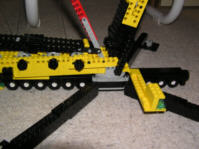 |
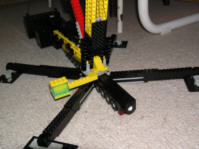 |
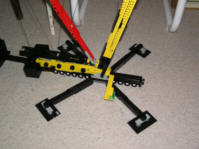 |
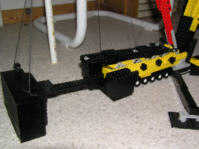 |
The superstructure of the crane has to diverge a lot from the scale, because of the size of the LEGO. The superstructure are
higher than the original because of the 4 winches mounted inside the construction.
The superstructure is built on top of the turntable, so is the junction for the main boom, this part of the superstructure
are very heavy made, to support the large boom.
The superstructure is equipped with 4 winches, one for the A-boom, one for the main boom, when the crane is equipped
with a superlift, one for the flyjib and finally one for the hoist. Alle winches are driven by crank handles on the left
side of the superstructure, on the right side I have made a little brake for all of the winches.
In the rear end of the superstructure the rollers for the A-boom is placed, which are used when the main boom or
superlifter has to be raised.
On each side of the superstructure, in the rear, there is a construction for carrying the counterweights. You can mount 4 train weights 73090
one each side, which gives about 0.5 kg total.
In the superlift it is possible to hang another couterweight, the superlift ballast. Here I have made a counterweight with a
weight of 1 kg, that is necessary to raise the boom. With the frame, and the relation between the weight of the counterwight and the superlift ballast, it is
posiible to raise and lower the ballast, and make it possible to turn the crane.
Since the scale is very small, it is hard to make a real lattice construction in the booms which looks like the original. It is also hard to make a stiff and durable construction. I choose to built the main boom and flyjib out of the long Technic beems, placed in a square, with spacers in between. The construction turned out to be good and durable for the construction. The main boom is 1.2 meters long, and the flyjib is 1.05 meters long. The total height of the crane is therefore 2.25 meters. The two A-boom which are used to luff the flyjib are both 0.3 meters.
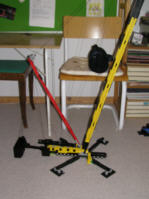 |
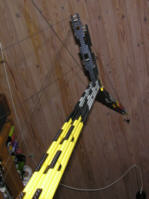 |
It was rather interesting to built a lattice boom crane, it turned out to bee a lot easier to built a 2.25 meter high crane as a lattice boom, compared to a telescopic crane on 2.4 meters, see Grove GMK4075. The construction turned out to be pretty stabil, and the crane was able to carry heavy loads. The biggest problem is to get the sideways stability, which is due the loss of stiffness and durability of the booms and turntable. The goal was to built a crane in scale 1:80, it was not very easy, and I had to make some of the crane a little out of scale, to implement the desired functions.
Below I have put the final data of the model.
 |
|
Setting up this type of crane is completed in 5 steps. Setting up the crane, mount and raise of superlift, mount of main boom and flyjib, raise of main boom and finally raise the flyjib. Below I have put a few pictures to show a part of the setting up of the LEGO model.